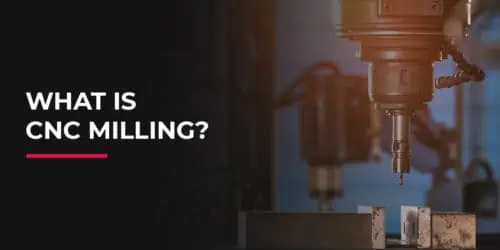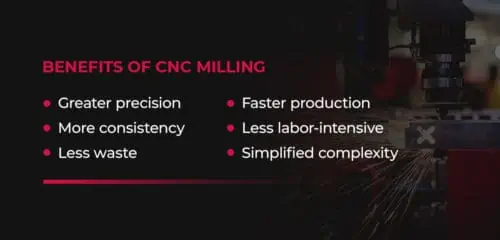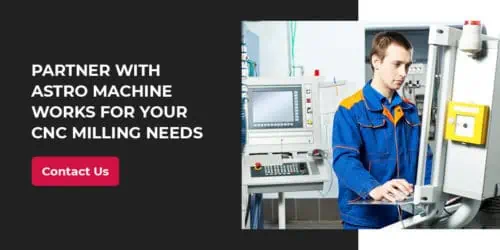What Is CNC Milling?

A computer numerical control (CNC) milling machine is a mill that uses computer code to understand where to make cuts.
Like all milling machines, a CNC mill produces a final piece by carving away from a block of material versus adding layers of material to a blank slate. However, unlike manual milling, CNC mills do not have to be operated by hand. You simply need the right computer software and a library of programs to instruct your machine on how to create the desired product.
CNC milling is just one type of CNC machining process your business could consider integrating to make your production more accurate and efficient.
Below, we’ll cover the advantages of CNC milling, which industries can benefit from using a CNC mill and how a CNC mill works.
Why Should You Use a CNC Milling Machine?
CNC milling has many advantages over manual milling, and this automated process can serve various industries — particularly sectors in which accuracy and consistency are paramount. The market for CNC milling machines is expected to achieve a compound annual growth rate of 8.1% through 2030, likely due to the range of benefits this equipment provides in various applications.
Advantages of CNC Milling
Because CNC mills operate based on computer programs rather than with manual workers, the process creates several benefits to boost your business’s bottom line, including:
- Greater precision: With computer programs running the cuts, CNC mills allow you to reach a higher level of precision than you could with a manual machine. Because these machines don’t rely on human operators, they leave less room for human error.
- More consistency: Another advantage of not having a human operator and minimizing human error is that CNC mills can produce more consistent products. If you need pieces that align precisely, take advantage of CNC milling’s automated uniformity.
- Less waste: Fewer errors mean CNC mills produce less waste. CNC machines can achieve higher efficiency with their cuts than manual machines.
- Faster production: Because they’re more efficient and don’t require a human operator, CNC machines can also complete a product much more quickly than manual mills.
- Less labor-intensive: Save on labor costs by outsourcing to a company that offers CNC milling. Doing so will also free up your current employees to work on other critical tasks because they no longer have to spend time operating a manual machine.
- Simplified complexity: If your piece requires many different cuts, tools or materials, many large CNC machines can more seamlessly integrate these changes, further contributing to a quicker, more efficient production process.
While CNC milling machines can be a costly investment, outsourcing your production to a company like Astro Machine Works allows you to take advantage of each of these benefits without paying the upfront cost of owning a CNC mill yourself.
Additionally, our operators have experience working with the software, which means you can trust us to produce high-quality products. By relying on our expertise, you benefit from the efficiency of CNC milling without dedicating the time and resources to learn the software yourself.
Applications of CNC Milling Machinery
While numerous industries can benefit from using CNC milling, the improved accuracy, efficiency, consistency and handling of complex projects make this type of production especially appealing to sectors such as:
- Aerospace industry: CNC milling benefits the aerospace industry in producing any number of large, complex parts, such as those used in modern turbines.
- Electronics manufacturing: As one example, electronics manufacturers can use CNC mills to create smooth, clean surfaces when producing casings for cell phones or laptops.
- Medical industry: The medical industry requires clean, accurate production. For example, when fabricating implants, the manufacturer needs near-perfect accuracy, making CNC milling a top choice.
- Military: Astro Machine Works proudly produces components for the United States military. CNC machining can create accurate, consistent parts for helicopters, missiles, naval ships and more.
Additionally, CNC milling works well with multiple materials. Compared to other CNC machines, such as CNC routers, milling machines handle hard metals like titanium and steel exceptionally well.
How Does a CNC Milling Machine Work?
Like a manual milling machine, a CNC mill works with a round rotating tool that cuts into a block of material. A platform attached to the machine holds and moves the material as needed to meet the cutting tool.
A CNC mill differs from a manual mill in how the operator directs it to cut a piece. Instead of manually controlling the machine, an operator will use computer software to program the cuts the mill should make.
How Does CNC Milling Work With Computer Software?
Computer-aided design (CAD) software allows manufacturers to create a 3D rendition of their product on the computer. This visualization process makes it easy to see what your product will look like once produced.
Though operator friendly, CAD software is not necessarily machine friendly. CNC machines require numerical code that provides precise coordinates describing where they will need to make cuts. That’s where computer-aided manufacturing (CAM) software comes in. An operator can seamlessly integrate your CAD prototype with CAM software, which will then translate the 3D design into numerical code the CNC machine can understand.
The end result is an incredibly precise reductive process that combines the benefits of automated manufacturing with milling machines’ wide range of motion across multiple axes.
Types of CNC Milling Machines
The number of axes is one of the primary ways we categorize CNC mills, in addition to the cutting tool’s orientation.
The number of axes in a mill ranges from three to five, with five-axis milling machines providing the broadest scope of movement. Because five-axis machines can rotate along the A and B axes and move along the x-, y- and z-axes, this type of CNC mill enables you to produce highly complex products. For simpler products, a three- or four-axis machine might work perfectly.
Additionally, we can define two types of CNC mills based on whether the cutting tool is positioned horizontally or vertically relative to the ground. Vertical mills are more common and are well-suited for quick, simple projects. Meanwhile, horizontal mills handle larger projects with ease.
Partner With Astro Machine Works for Your CNC Milling Needs
Whether you need to manufacture precise parts for a complex machine or highly accurate medical tool or uniform pieces for a project that demands consistency, a CNC milling machine can get the job done quickly and efficiently. Partner with Astro Machine Works to take advantage of our CNC machining capabilities and work with experts at a company with 30 years of industry experience.
We have both three- and five-axis CNC mills and up-to-date CAD and CAM software. With ISO 9001 and AS9100 certifications, we uphold strict quality standards to exceed your expectations. Learn more about our CNC machining services today!



